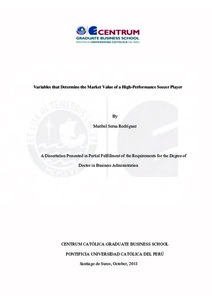| dc.description.abstract | The research question of this study was identify the variables that determine the
market value of a high-performance soccer player, in the five major leagues around the
world (Premier League, Bundesliga, LaLiga, Serie A and Ligue 1). The research question
allowed to establish a hierarchy-of-hypotheses (see Table 1). Consequently, there are nine
major hypothesis, 45 sub-hypothesis, and 20 sub-sub-hypothesis.
The sample was conformed by 335 soccer players for the main five soccer leagues,
distributed according to the proportional affixation for random stratified sampling. . The
information for 45 control variables and the endogenous variable for 335 ssocer players
was collected from the transfermarkt.de. website that is an online community (crowd
wisdom).
The 45 control variables that arised from the literature systematic review had
having to be grouped in these major major hypotheses (smaller clusters or groups). For
this purpose, these variables was categorized in talent indicators and external variables.
Through this categorization, the 45 control variables were grouped together in five clusters
according to the similarity between them. Finally, nine smaller clusters or groups were
formed using divisive hierarchical clusters according to the dissimilarity between the
variables. More variables had to be incorporated for some groups because the
operationalization process for six variables generated other variables. In that order was
structured a hierarchy-of-hypotheses (HoH), 45 variables take place to nine major
hypothesis (groups), 45 sub-hypothesis (variables that belong for each group), and 20 subsub-hypothesis (levels of each variable).
To answer the research question taking into account model uncertainty (variable
selection) in a framework with 35 billion potential models, it was used a hedonic
regression framework, and implement Bayesian model averaging (BMA) through Markov
vii
chain Monte Carlo model composition (����3
). To deal with endogeneity issues,
instrumental variable Bayesian model averaging (IVBMA) was implemented as well. In
the latter case, the potential endogeneity between Market value and Performance was
addressed using Performance as an instrumental variable and Coach and Change of team
as instruments.
Using the BMA mechanism, there is evidence to support the sub-hypothesis H1m
(PIP=1.000), H3a (PIP=1.000), H5c (PIP=1.000), H6b (PIP=1.000), H1b (PIP=0.993), and
H3c (PIP=0.992). Therefore, four variables (Performance, National team, Age, Goals, and
Recognition under-21) are a value-drivers that generate a positive effect on the market
value of the soccer player; and one variable (Age squared) is a negative value-driver that
generates a negative effect on the market value of the soccer player.
Using the IVBMA mechanism, there is evidence to support the sub-hypothesis H1m
(PIP=1.000), H3a (PIP=1.000), H5c (PIP=1.000), H6b (PIP=1.000), H3e (PIP=0.997), and
the sub-sub-hypothesis H7b1 (PIP=1.000). Therefore, four variables (Performance,
National team, Age, First division, and Recognition under-21) are a value-drivers that
generate a positive effect on the market value of the soccer player; and one variable (Age
squared) is a negative value-driver that generates a negative effect on the market value of
the soccer player. | es_ES |





